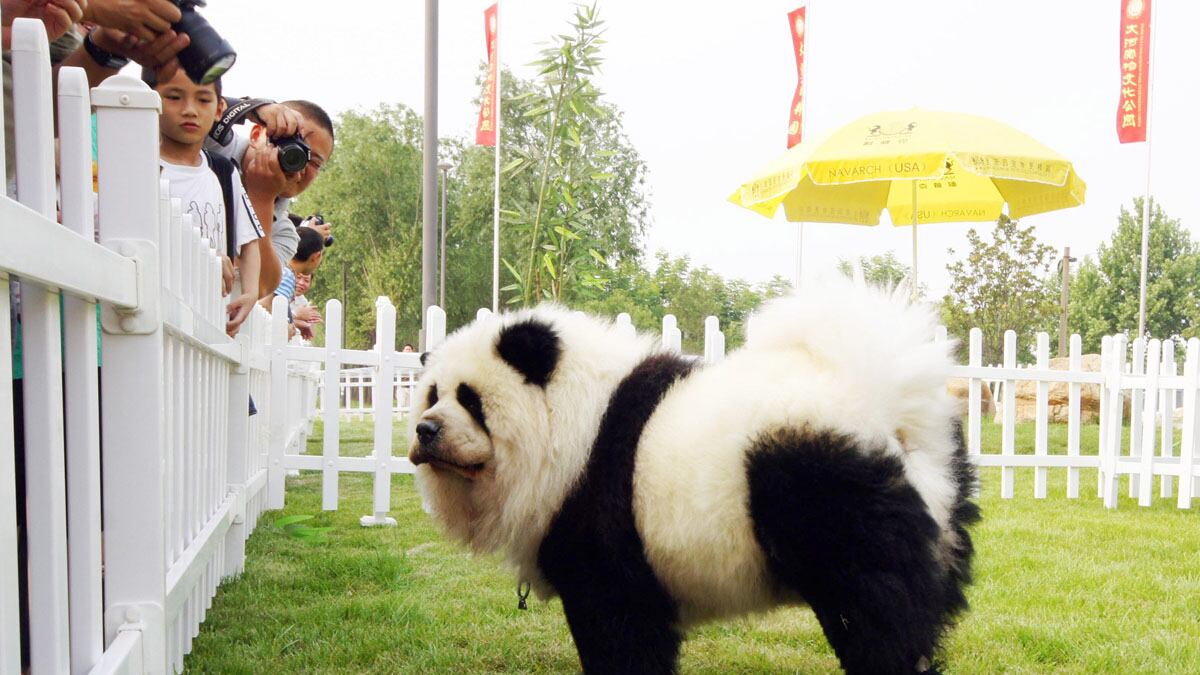We still can’t stop staring at them, even if photos of Asian dogs dyed to imitate other wild animals—pandas, tigers, buffalo, snails, even Ninja Turtles—first appeared online more than two years ago.

The trend has since spread to the West, where dog lovers have become fans of utilizing man’s best friend as fashion statement. Recently two owners of technicolor dogs told CNN’s Anderson Cooper their trophy canines loved the attention they got after their extreme makeovers. One of them (the dog, not owner) was two-tone, with a chartreuse mane and red ears. But that’s puppy play compared with China’s converted canines, where the art of dyeing dogs to imitate beasts is taken to the extreme.
Here, deep research has gone into which breeds best mimic which beasts. For instance, the best panda wannabes are furry white Chow Chows, insists Wang Lishi at the massive Liyuan Dog Market on the outskirts of Beijing, where alleys are lined with barking canines and pet shops burst at the seams with dog paraphernalia. “With a good dye job, they look just like pandas—until they open their mouths, and then you see their tongues are blue.” Golden retrievers can successfully masquerade as tigers. With the right comb-outs, poodles and Bedlington terriers credibly imitate camels and bison.
But Wang does not approve of the trend. “It’s not natural. These days even people are letting their hair go natural, without dyes. Please don’t dye your dog.” I point out that hair-dyeing was increasingly popular among Chinese, and that many members of the Politburo Standing Committee dye their hair jet black. Wang shoots back, “Dyeing harms the dog; animals have rights, too. If you want a pet that looks like a panda, just go out and buy a panda!”

At least by Chinese standards, moreover, transforming your pooch into a panda can eat up a lot of time and money. The Pai Duo Get Pet Grooming Center in Beijing can do the job. “However, the dye job takes about five hours, and costs at least 600 yuan,” or nearly $100, says one employee. “And you have to be extremely careful about the dyes. Human hair dye is toxic for dogs. We use only nontoxic coloring, but even so we recommend you shouldn’t dye your dog more than once every six months.”
What’s extraordinary about the extreme dog-grooming craze is how it reflects changing cultural norms. During the enforced egalitarianism of the 1966–76 Cultural Revolution, very few ordinary citizens owned dogs. Back then, the canine was considered a “bourgeois” pet because dogs didn’t contribute to society but still had to be fed. (Cats, which caught rats, were tolerated.)
That began to change in the 1980s, when dog ownership mushroomed. But as recently as the ’90s, “dog patrols” in Beijing and other cities routinely walked the streets searching for dogs without proper permits and shots. They sometimes clubbed unlicensed dogs to death right in front of their horrified owners.

Even today, dog meat—euphemistically called “fragrant meat”—is still consumed in many rural areas. In certain markets of southern China, live dogs are crammed inhumanely in tiny cages stacked alongside vendor stalls piled with cooked dog carcasses destined for the dinner table. Earlier this month, a Chinese animal-protection activist kneeled and kowtowed in front of a mass of slaughtered dogs in a Guangxi province market—“apologizing” to the dead animals— to promote his campaign against the human consumption of dog meat.
In this regard, China may be unique in terms of its rich-dog/poor-dog dichotomy. But even as poor Chinese households serve up “fragrant meat” for dinner, dogs that end up with extreme makeovers should consider themselves lucky to simply wind up dyed, not dead.






